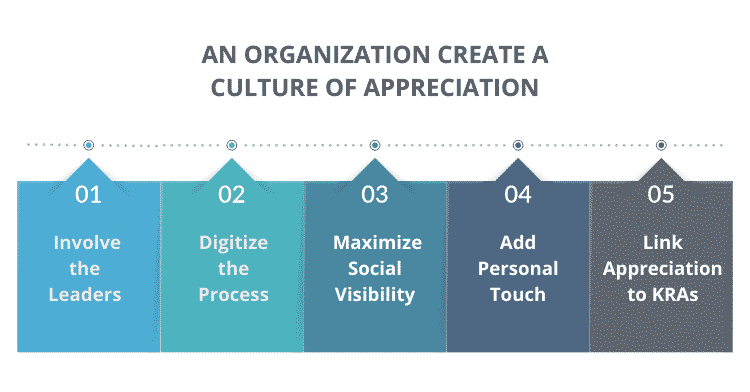1. Encourage Leadership Involvement: Leaders should practice and promote appreciation to set a cultural example.
2. Utilize Digital Tools: Implement digital platforms for easy, accessible employee recognition across all locations.
3. Increase Social Visibility: Publicly share recognition on internal and external platforms to create a positive and motivating environment.
4. Personalize Recognition: Use personalized notes or direct communication to make appreciation more genuine and impactful.
5. Tie to Performance Metrics: Include recognition practices in performance evaluations to encourage consistent appreciation among all employees.
One proven way to build an engaged workforce is to create a strong culture of appreciation in the organization. Such a culture can go a long way in promoting employee commitment, loyalty, and engagement.

A ‘Culture of Appreciation’ is a work environment where appreciation and acknowledgment are normal behavior, almost like a habit for supervisors and employees, without additional impetus from the HR or the management.
You can also refer to it as the ‘Attitude of Gratitude.’

It can foster business growth and creativity by boosting the morale and confidence of the employees.
Here are a few best practices for building such a culture of appreciation in any organization:
1. Involve the Leaders
2. Digitize the Process
3. Maximize Social Visibility
4. Add Personal Touch
5. Link Appreciation to KRAs


The best way to start building a culture of appreciation in an organization is to encourage the leadership team to practice and preach.
The leaders should make it a point to use every possible interaction with the employees to appreciate and acknowledge their achievements.
Floor meetings, team huddles, town halls, Zoom calls, and other forums are great for practicing and demonstrating the art of appreciation.

The organization can make it simple and convenient for managers to appreciate their team members and peers to appreciate each other by leveraging a digital employee recognition platform.
Hence, the organization can implement Spot Awards and Peer-to-Peer Recognition in their employee recognition system.
Such systems make it easy for employees to appreciate one another digitally, no matter where they operate.

Leveraging internal platforms such as MS Teams, Slack, and the company intranet to showcase the appreciation/ recognition received by employees are good way to create social visibility around the practice of appreciation.
It can create a positive feeling for the winners and encourage others to appreciate their team members, creating a virtuous circle.
Sharing the recognition on public social media platforms such as Facebook and LinkedIn can create additional visibility.

While using digital platforms to appreciate employees can be convenient, it can also make the process more impersonal.
Hence, organizations should encourage supervisors and managers to appreciate and recognize employees personally, whenever possible.
This can also happen over a voice, video call, or text message.
A well-written and personalized thank you note can add to the personal touch.

Making appreciation and recognition of team members a part of the performance evaluation criteria of managers and leaders can also encourage them to make it a regular practice.
Peer appreciation can be one of the positive behavioral traits expected from all employees.
Making it a part of the KRAs will encourage employees to practice it regularly, eventually making it a habit.
Building a strong culture of appreciation assures employees that they are valued by their employers and peers. This enhances their sense of self-worth and makes them active contributors in the process of growth and success of the business.

Lead author: Sagar Chaudhuri, the Co-Founder and CEO of HiFives. He is an HR Tech Evangelist with over 25 years of corporate and entrepreneurship experience. In the past, Sagar has worked in leadership roles with companies such as Genpact, Infosys, and ICICI Bank. He has an engineering degree from IIT Kharagpur and an MBA from IIM Lucknow. Connect on LinkedIn
To stay updated on the latest HiFives blogs, follow us on Twitter (@MyHiFives)